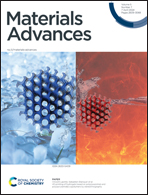Cationic and oxygen defect modulation for tailoring the bandgap and room temperature ferromagnetism of CuO via multiple d-block cations†
Abstract
The potential of oxide-based dilute magnetic semiconductors (DMSs) for use in spintronics and magneto-optic devices has garnered a lot of attention over the years. However, the optical and magnetic behavior of these DMSs is challenging to navigate due to the complicated interactions of intrinsic defects. In these contexts, the current research takes a comprehensive look at the pristine and simultaneously multiple d-block cation (Cr, Fe, Ni, Co, and Zn)-doped CuO nanocrystals (NCs) to explain the defect interactions inside the lattice. Structural analysis revealed a highly crystalline monoclinic crystal structure in the C2/c space group. The phase stability of CuO NCs was found to decrease with increasing dosages of dopants, ultimately forming a secondary phase of Cu metal. Diffuse reflectance spectroscopy (DRS) spectra showed narrowing of the optical band gap, attributing it to the presence of impurity states between the conduction band minimum (CBM) and valence band maximum (VBM) as a result of doping. These impurity states can inhibit carrier recombination. Both pristine and doped CuO NCs showed ferromagnetism at ambient temperature with a paramagnetic tail at higher fields. This paramagnetic tail, explained based on the thermomagnetization curves, corresponds to the easy flip of magnetic cations below room temperature. All the ferromagnetic features of CuO NCs may be traced back to the exchange interaction between the spins of magnetic ions, mediated by carrier-trapped vacancy centers. Interestingly, doped oxides showed improved ferromagnetism when used at moderate concentrations, which is related to the creation of a larger number of bound magnetic polarons (BMPs). However, higher dosages of dopants lower the concentration of BMPs by delocalizing the carriers from the defect centers.



 Please wait while we load your content...
Please wait while we load your content...